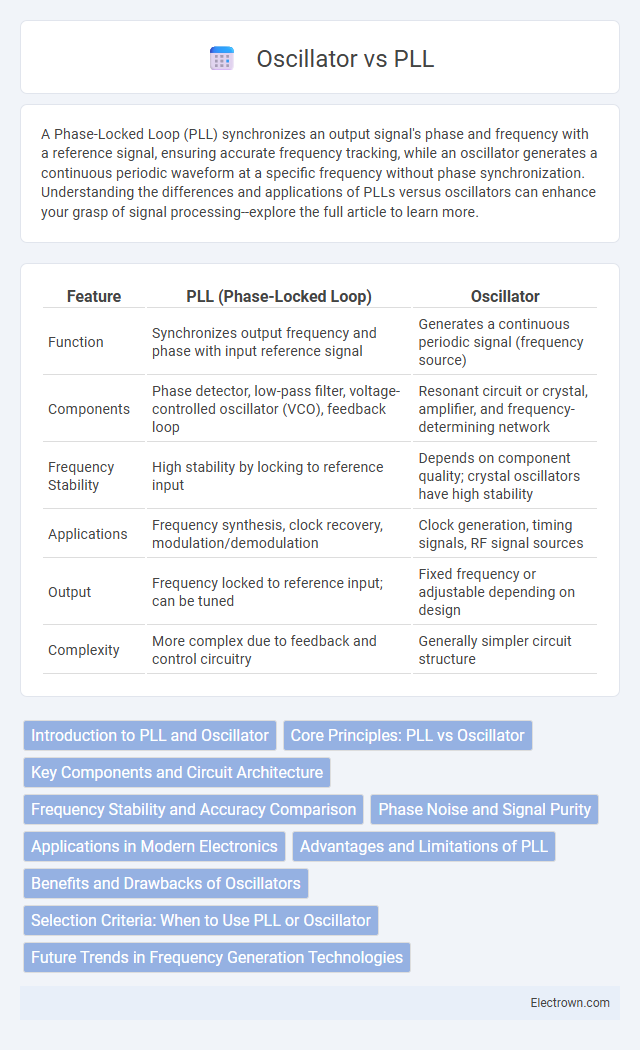A Phase-Locked Loop (PLL) synchronizes an output signal's phase and frequency with a reference signal, ensuring accurate frequency tracking, while an oscillator generates a continuous periodic waveform at a specific frequency without phase synchronization. Understanding the differences and applications of PLLs versus oscillators can enhance your grasp of signal processing--explore the full article to learn more.
Table of Comparison
| Feature | PLL (Phase-Locked Loop) | Oscillator |
|---|---|---|
| Function | Synchronizes output frequency and phase with input reference signal | Generates a continuous periodic signal (frequency source) |
| Components | Phase detector, low-pass filter, voltage-controlled oscillator (VCO), feedback loop | Resonant circuit or crystal, amplifier, and frequency-determining network |
| Frequency Stability | High stability by locking to reference input | Depends on component quality; crystal oscillators have high stability |
| Applications | Frequency synthesis, clock recovery, modulation/demodulation | Clock generation, timing signals, RF signal sources |
| Output | Frequency locked to reference input; can be tuned | Fixed frequency or adjustable depending on design |
| Complexity | More complex due to feedback and control circuitry | Generally simpler circuit structure |
Introduction to PLL and Oscillator
A Phase-Locked Loop (PLL) is an electronic control system that synchronizes an output oscillator signal with a reference input signal, ensuring stable frequency and phase alignment. Oscillators generate periodic waveforms, such as sine or square waves, used in clocks, radios, and communication devices. You rely on PLLs for precise frequency control and oscillators for generating consistent timing signals in electronic circuits.
Core Principles: PLL vs Oscillator
A Phase-Locked Loop (PLL) continuously compares the phase of its output signal with a reference signal, dynamically adjusting to maintain synchronization, which enables frequency synthesis and signal stability. In contrast, an oscillator generates a periodic waveform based on a resonant circuit or crystal with a fixed frequency determined by its physical components. While oscillators produce a standalone signal, PLLs serve as control systems that lock onto and track frequency changes, improving accuracy and reducing phase noise.
Key Components and Circuit Architecture
A PLL (Phase-Locked Loop) consists of a phase detector, a low-pass filter, and a voltage-controlled oscillator (VCO), working together to synchronize an output signal's phase and frequency with a reference input. In contrast, a standalone oscillator relies on resonant components like crystals or LC circuits to generate a stable frequency without external feedback. Understanding the differences in circuit architecture helps optimize your design for applications requiring precise frequency control versus simple signal generation.
Frequency Stability and Accuracy Comparison
Phase-locked loops (PLLs) offer superior frequency stability compared to standalone oscillators due to their feedback control mechanism that continuously corrects phase errors, minimizing frequency drift caused by temperature variations and supply voltage changes. Oscillators, such as crystal oscillators, provide inherently high frequency accuracy but can suffer from long-term drift and sensitivity to environmental factors without stabilization. PLLs achieve higher overall frequency accuracy in dynamic environments by locking the output signal to a precise reference frequency, making them ideal for applications requiring consistent timing and synchronization.
Phase Noise and Signal Purity
Phase-locked loops (PLLs) offer superior phase noise performance compared to free-running oscillators by continuously correcting frequency deviations, resulting in enhanced signal purity. Oscillator phase noise directly influences the spectral purity and stability of RF signals, making low phase noise critical in applications like communication systems and radar. You can achieve cleaner, more stable signals using PLLs, especially in environments demanding high spectral purity and minimal jitter.
Applications in Modern Electronics
Phase-locked loops (PLLs) and oscillators serve critical roles in modern electronics; PLLs are extensively used in frequency synthesis, clock generation, and signal modulation due to their ability to lock output frequency to a reference signal with high precision. Oscillators, including crystal and voltage-controlled types, are fundamental components in timing circuits, providing stable and accurate frequency sources for microcontrollers, communication systems, and digital signal processing. The integration of PLLs with oscillators enhances frequency stability and phase noise performance, essential in wireless communication, radar systems, and high-speed data converters.
Advantages and Limitations of PLL
Phase-Locked Loops (PLL) offer precise frequency synthesis and improved signal stability compared to standalone oscillators, making them ideal for applications requiring accurate frequency control and low phase noise. PLLs can dynamically track input frequency variations and suppress noise, but they may introduce complexity, require careful loop filter design, and exhibit limited locking range compared to traditional oscillators. Your system benefits from PLLs when frequency modulation accuracy and synchronization are priorities, but simpler oscillators might be preferred for straightforward, stable frequency generation without added design constraints.
Benefits and Drawbacks of Oscillators
Oscillators generate continuous periodic signals with stable frequency, essential for clock generation in electronics, but their frequency can drift due to temperature and component aging. They offer simplicity and low power consumption compared to PLLs, making them suitable for basic timing tasks. However, oscillators lack the frequency synchronization and phase noise reduction capabilities inherent in PLL systems, limiting their precision in advanced communication applications.
Selection Criteria: When to Use PLL or Oscillator
Select a Phase-Locked Loop (PLL) when frequency stability, signal synchronization, and low phase noise are critical, particularly in communications and signal processing applications. Opt for a standalone oscillator if simplicity, fixed frequency generation, and cost-effectiveness are primary concerns, such as in clock generation for microcontrollers. Evaluate requirements including frequency accuracy, jitter tolerance, power consumption, and system complexity to determine whether a PLL or oscillator best suits the design goals.
Future Trends in Frequency Generation Technologies
Future trends in frequency generation technologies emphasize the integration of PLLs (Phase-Locked Loops) with advanced oscillators to improve phase noise performance and tuning range. Emerging applications in 5G, IoT, and quantum computing drive demand for low-power, high-precision frequency synthesizers leveraging fractional-N PLL architectures and MEMS-based oscillators. Innovations in semiconductor materials and AI-assisted control algorithms further enhance stability and reduce phase jitter, enabling more reliable and compact frequency generation solutions.
PLL vs oscillator Infographic

 electrown.com
electrown.com